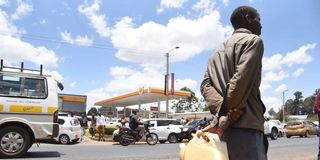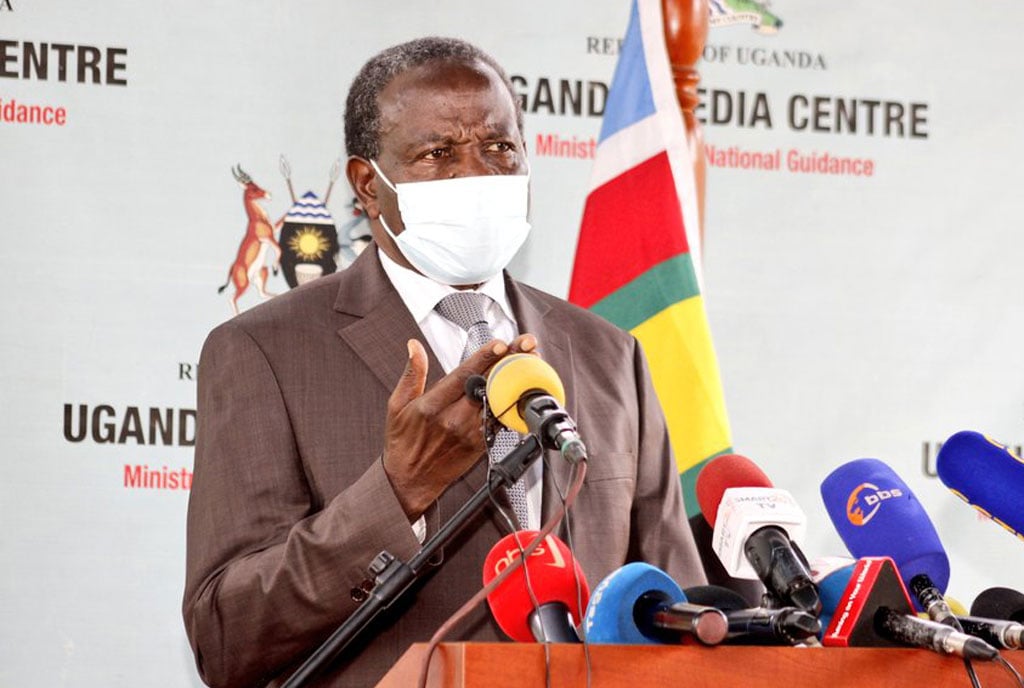Why fuel shortage has hit some towns in Kenya

A man with jerricans waits to buy fuel in Eldoret town on April 3, 2022 amid a biting shortage. Kenya is staring at a fuel crisis due to delays in subsidy payouts by the government. PHOTO/ NMG
What you need to know:
An acute fuel shortage was reported in parts of the country this week, including the North Rift
Kenya is staring at a fuel crisis due to delays in subsidy payouts by the government.
This has affected cash flow for some petroleum marketers, leaving them unable to buy new stocks.
An acute fuel shortage was reported in parts of the country this week, including the North Rift. The Energy and Petroleum Regulatory Authority (Epra) acknowledged the shortage but blamed it on supply hitches without disclosing solutions.
“The shortage is occasioned by unprecedented logistical constraints. These challenges have caused independent petroleum dealers to run out of petroleum stocks,” said Epra in a statement.
“There are enough fuel supplies in the country and there should be no cause to panic.”
Sources who spoke to Nation.Africa linked the fuel shortage to delays in reimbursing more than Sh13 billion in subsidy cash to oil marketers. The state introduced the scheme last year, where it pays oil marketers for the high cuts on their margins to keep recommended pump prices.
Fuel subsidy
The government partially applied the fuel subsidy this month, which saved consumers from paying KSh155.11 for a litre of petrol. Epra said consumers would have paid KSh143.16 for diesel and KSh130.44 for kerosene had the state not intervened, underlining the importance of the subsidy.
Delays in the subsidy payout mean that oil marketers either have to tap into their cash reserves or take loans to restock their fuel supplies.
This comes even as the landed cost of the products continues to rise, leaving oil marketing firms in an even deeper conundrum.
For instance, the landed cost of petrol rose 13.34 per cent to $676.4 (KSh77,717.88) per cubic metre in February, while that of diesel rose 11.74 per cent to $677.31 (KSh77,822.44). Kerosene increased the highest by 15.94 per cent to $619.57(KSh71,188.15).
Petroleum Principal Secretary Andrew Kamau on Wednesday admitted there was a delay in subsidy payouts and linked it to an ongoing verification of the amounts due to each firm based on their sales volumes.
One-month delay
“There is a one-month delay. This is due to the verification process that takes place to make sure the right companies are paid the right amounts,” he told Nation.Africa.
Mr Kamau, however, said the shortage would also be a result of high crude prices in the global market, which has rendered stocks unaffordable for some companies.
“The subsidy is not the problem. It is the high cost of the imports that may cause some problems, depending on the financial muscle of the marketer,” the PS said.
Global crude prices have been on the climb following tight supplies due to the Russia-Ukraine conflict, with marketers warning of steeper prices in the next price reviews – further complicating matters for the state that already faces a dilemma over its fuel subsidy scheme.
Oil prices on Wednesday jumped by more than $4 (KSh459.74) to $114.4 (KSh13,11.98) a barrel on supply tightness and prospects of new Western sanctions against Russia. Central Bank of Kenya Governor Patrick Njoroge said the government plans to gradually wean Kenyans off the fuel subsidy.
Crude oil prices
Terming the subsidy “unsustainable” in the long term, Dr Njoroge said the current high fuel prices mean the government cannot keep up, and it plans to borrow fiscal policies from advanced economies on how to tame fuel costs and end the subsidy.
“We do expect that the fuel subsidy in Kenya will remain but it may not be at 100 percent. There will be adjustments that will put some burden on the consumers,” said the CBK boss at a press briefing after a meeting of the Monetary Policy Committee (MPC).
He said Kenya is studying how developed economies deal with fuel prices to inform how the country will move forward. Countries have initiated numerous measures to tame the effect of the spiralling global crude oil prices, including varying subsidies and tax cuts to cushion consumers.
“It (the subsidy) has to be short term, it can’t be over the long term. We have seen how some countries can be caught up in this and be unable to remove it in the long term. We are looking forward to actions by the advanced economies to lower those prices,” said Dr Njoroge.
“Prices at $100 a barrel are completely beyond the realm of understanding. The actions that they can do will be beneficial to allow us to withdraw the subsidies at the right time.”
Authored by Brian Ambani




